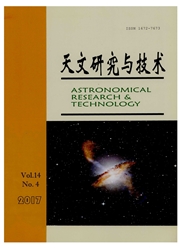

 中文摘要:
中文摘要:
首先回顾了在现场射电望远镜天线性能的Y系数测量方法,指出如略加改进并利用射电望远镜自身接收机作测试接收机,则即能测出天线性能,又能测出接收机性能,详尽描述了这种改进方法。测量方法是模拟接收机输入端分别连接到50Ω终端、噪声源及天线输出端,且天线分别指向冷空和太阳。由测量方法得出4个传输方程,进而导出模拟接收机系统噪声温度、天线噪声温度、模拟接收机增益及天线增益与测试数据紧密联系的表达式。以一个射电望远镜测试数据为依据,算出相应系统参数并与设计指标要求进行了比对。小结中列出这种方法的优点,同时也讨论了现场测量天线增益的方向图法。
 英文摘要:
英文摘要:
This paper first reviews the Y factor method to measure the antenna performances of radio telescopes on site. We point out that with a few improvements and using the telescope receiver also as the receiver for performance measurement, the antenna and receiver can both be measured. The paper describes such a synthetic measurement method of performances of the antenna and receiver in a radio antenna array. The method is proceeded that the analog receiver input is connected to the 501-1 terminal and noise source, and the antenna is pointed toward the cold sky and the sun, all in proper alternating order. Four sets of radio powers are consequently measured and recorded (P50, PNS, PSKY, and PSUN). The formulae of the gain and noise temperature of the antenna and receiver can be derived according to the method. We have measured and calculated the corresponding parameters, and have compared them to the design specifications. We also discuss the pattern method to measure the antenna gain on site.
 同期刊论文项目
同期刊论文项目
 同项目期刊论文
同项目期刊论文
 期刊信息
期刊信息
